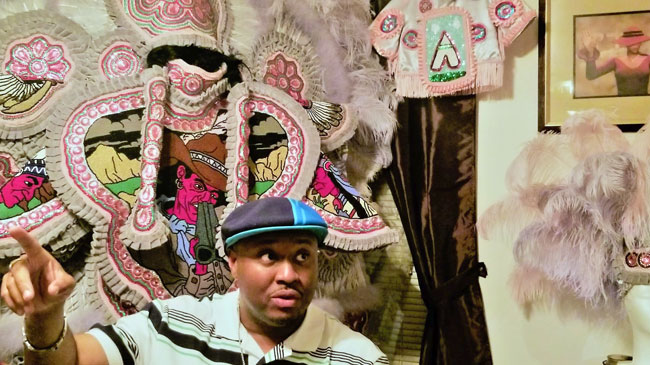
By Glenn Jones
Tribal Timeline: Golden Blades
1936 – 1944’s Big Chief Ben Clark
1945 – 1947 – Big Chief Leon “Happy Peanut” Robinson
1948 – 1949 – Big Chief Robert Nathaniel “Robbe” Lee
1949 – 1950 – Big Chief Leon “Happy Peanut” Robinson
1950 – 1970 – Big Chief Paul Longpre
1999 – present – Big Chief Derrick “Golden Blade” Hulin
“When that machete hit that flag, all butterflies, all the nervousness, all that went out the door! Cause at that point I knew it was serious business.”
Big Chief Derrick “Golden Blade” Hulin received his blessing to bring his own gang out by his, than Big Chief Bo Dollis Sr. of the Wild Magnolias as well as Curtis “Suge” Williams (first Chief Golden Blade), late Jake Millon of the White Eagles, Lil Walter Cook of the Creole Wild West, Charles Taylor of White Cloud, late Tootie Montana of Yellow Pocahunters, Big Chief Larry Baniot of Gold Star Hunters as well as Big Chief Sugar Bear of the Black Mohawks and Big Chief Paul Longpre to bring the tribe Golden Blades back on the streets.
As impressive as this list of chiefs is, it doesn’t surpass the relationship of his first major supporter his father Irving Hullin. At the age of 4 his father helped him make his first unofficial Indian suit (where pops played his first unofficial Spy Boy) and brought him to meet Indians on Mardi Gras. Going out from HollyGrove at 5am in the morning at age 16 for the first time as Flag Boy for the Wild Magnolias he was met by a machete swinging spy boy who grew up to be Big Chief Demond Melancon of the Young Seminoles.
From starting off with the Wild Magnolias as a Flag boy to becoming Chief in 1999 and bringing out his first Big Chief suit in 2001 till now, Big Chief Golden Blade attest his leadership to the lessons of Chiefs that came before him. In some of our past interviews we speak on the ways this culture can cause a riff in families. In this case we see the beautiful opposite.
Q. What is the difference between beading and bead work?
A. Running straight lines is beading. When you have details and intricate colors its beadwork.
Q. In your time of masking, what’s a lost tradition you feel should come back?
A. The way they meet, the way how they play (Indian protocol), and signals. When we use to meet we use to be blocks away from each other and we did that for a reason to stretch the tribe out, so we could communicate with the signals.
Q. You’ve given blood, sweat, tears, and many years to this culture, what has this culture given you?
A. The culture has taught me so much in terms of being a leader amongst men and women, to have compassion in certain aspects, to be stern in certain aspects, to grow to be a man. If you’re around the right people and being taught by the right people it teaches you to be that great leader, that great man to stand on your word, say what you mean, mean what you say, don’t backbite on nothing. It’s gonna come with repercussions but guess what, they will respect your mind better by telling the truth. The Indian Culture has taught me a lot and it don’t owe me anything at the end of the day.
Q. What are your responsibilities as Chief?
A. First and foremost make sure that your Indians respect themselves, each other, and Indians from other tribes. Second of all they must learn the reasons of why they want to mask, not just because it’s fun. They have to understand why we do what we do. We’re not just doing it to have a ball. We have to make sure they know the value of signals because when you’re playing Indian you don’t communicate verbally you communicate with your tribe via signals. We have to teach them the songs and the reasons why we’re singing these songs and the meaning behind these songs. Whether it’s a battle cry or respectable song we have reasons. You also have to learn how to sew. Everything you put in you have to learn how to thread that needle and sit there and put in the time and dedication to make it come alive. All of it works together, there’s not one part greater than the other. You could have a nice suit and just don’t know what you’re doing and all you’ll be is a manikin.
Q. As a Chief what does singing mean to you in this culture?
A. Your singing is your life, your singing is your years. You sing about your experiences so at that point it doesn’t become a song it becomes your documentary.
Q. What role did this culture play in your relationship with your father?
A. When the Indian thing came about it gave us a chance to work together, we sewed together, we hung together and talked, he’s seen my mistakes and I saw his mistakes, and we basically fed off each other. We were in tandem all the way up until about two or three years ago because his eye sight started getting a little weak. Whereas a lot of guys may have a lot of help on these suits, it’s always been me and him, always.
Q. What is the spirit of your Tribe?
A. The spirit of Golden Blades is strictly old school tradition. I was brought up that way and I teach them the same values. I have Indians in my tribe that masked in the 60’s and 70’s. That’s all we know is old school values.
Q. What do you want the legacy of your tribe to be in the next 300 years?
A. I want my tribe to be known for being good old school tough Indian and look great period. We teach the game we preach the game we good playing the game and that is our legacy from day one. As a Chief I want to be known as a great leader a great artist and a great teacher. I do believe in teaching. I don’t only teach my tribe I teach members of different tribes. I love history, I love this Indian thing. Me sitting here talking about it, I can run millions of stories to you of my personal experiences, but there’s always a lesson behind those stories. That’s my job, it’s to teach those lessons behind the story. 300 years from now I want to be one of those guys they talk about that was always pretty, he knew the game, brought the game and he taught the game.
Big Chief Golden Blade is a historian of this culture. I could not fit the many bloodlines of tribes and past Chiefs we discussed in our conversation. Wait for full interview on www.bnola.net.
Recommended For You.



Be the first to comment